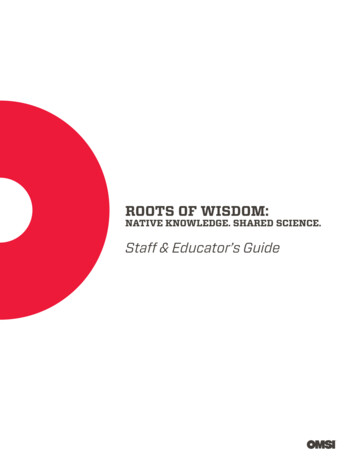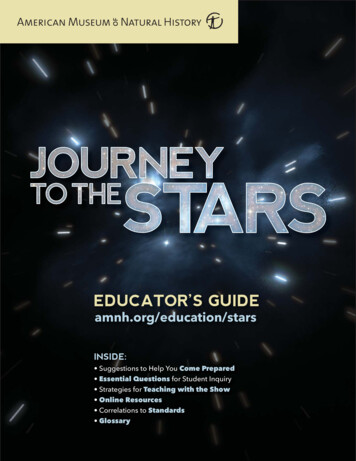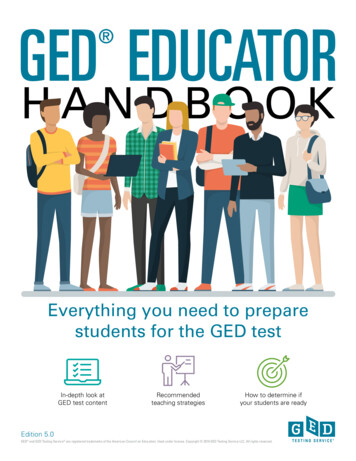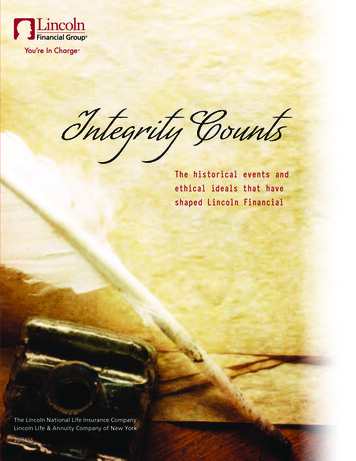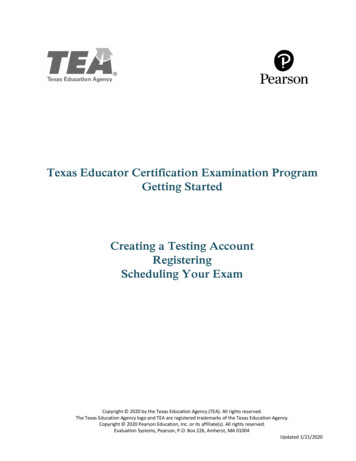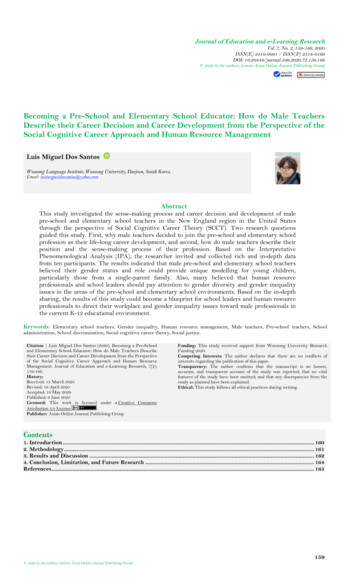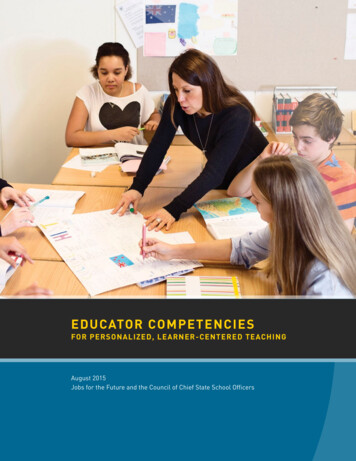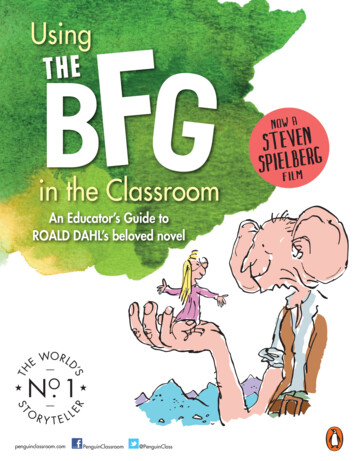
Transcription
UsingNow ain the ClassroomAn Educator’s Guide toROALD DAHL’s beloved lassSTEVENGREBLEIPS FILM
Dear Educator,You and your students have certainly read (and watched!) Roald Dahl’s beloved Matilda and Charlie and the ChocolateFactory, so it’s time to take a giant leap into the extraordinary world of The BFG. Author Roald Dahl’s magicaladventure is so rich in fantasy that it must be washed down with a heaping glass full of frobscottle.This educator’s guide will engage your students in activities that are designed to promote thoughtful examination of thetext, while challenging them to become the type of writers who inspire emotion and passion in their own readers.Roald Dahl shared seven tips on the qualities needed to become a successful writer. These tips are integrated into sevendifferent intriguing activities in the pages that follow. Each activity will promote thoughtful reflection and imaginativesynthesis in your students, and ultimately inspire them to create their own stories.Objectives of this Educator’s Guide include: Stimulating imagination Considering Roald Dahl’s language of Gobblefunk Creating visual imagery from the written word Helping your students to develop stamina as a writer Assessing point of view Considering social impact Practicing powers of persuasionWe have also included a guide to using the audiobook with your students, creating a multi-sensory experience in theclassroom.Inspire your students to dream, to believe, to laugh and to play with story ideas. Remember, “It’s impossible to makeyour eyes twinkle, if you aren’t feeling twinkly yourself.”—Danny, from Danny the Champion of the WorldFrom your friends atPenguin School & Library Marketingopens in U.S. theaterson July 1, 2016,the year that marks the100th anniversary ofRoald Dahl’s birth.Walden Media and the Walden Media skippingstone logo are trademarks of Walden Media, LLC.
Roald Dahl’s Beloved Novel Comes to Lifewith three of the world’sGREATESTSTORYTELLERSThe talents of three of the world’s greatest storytellers—Roald Dahl,Walt Disney and Steven Spielberg—finally unite to bring Dahl’sbeloved classic The BFG to life. Directed by Steven Spielberg, Disney’sThe BFG tells the imaginative story of a young girl and the Giant whointroduces her to the wonders and perils of Giant Country.The BFG is not the first time that the creative visions of Walt Disney (L) and Roald Dahl (R)were connected. In 1942, Roald Dahl wrote what might be his first story for children, TheGremlins. It is based on tales told in the Royal Air Force, where Dahl was a pilot who was shotdown over Libya during World War II. To members of the RAF, gremlins are the little creaturesresponsible for the various mechanical failures of airplanes, as the pilot of the story, Gus,discovers. Dahl’s story found its way to Walt Disney, who liked it so much he wanted to turnit into a movie. Though the movie itself never came to pass, The Gremlins was released as abook by Walt Disney and Random House, with proceeds going to the RAF Benevolent Fund.Dahl gave away many copies of the book, including one to then-First Lady Eleanor Roosevelt,who is said to have read the story to her grandchildren. In the photo above, Walt Disney andRoald Dahl examine “gremlins” designed to go along with Dahl’s story. Ironically, in 1984the film, Gremlins, loosely inspired by Dahl’scharacters, was created by Steven Spielberg’scompany Amblin Entertainment, with Spielbergand Kathleen Kennedy and Frank Marshall asExecutive Producers—the samefilmmakers creating The BFG .
Using Dahl’s 7 Tips for Imaginative WritingInspiring a HOPSCOTCHY IMAGINATIONTip #1: Roald Dahl’s writing is rife with wild imagery and inventions of fantasy. Therefore, his first tip should come asno surprise to fans of Roald Dahl. To be a writer, he claims, “You should have a lively imagination. “Sound Symphony: This activity encourages students to participate effectively in a range of conversations whileusing technology to imaginatively synthesize ideas. Read the following passage to students, ‘Such wonderful andterrible sounds I is hearing!’ he (the BFG) said. ‘Some of them you would never wish to be hearing yourself! Butsome is like glorious music!’ The BFG hears everything with his truck-sized ears. Instruct students to work in groupsand brainstorm glorious and terrible sounds. As a whole group, discuss what makes some sounds glorious whileothers are disagreeable. Culminate this activity with students using an audio mixing program such as Garageband tocompose symphonies of glorious vs. terrible sounds. Use audio files or have students record their own sounds insideand outside the classroom.For Students’ Use: List the most glorious versus the most terrible sounds in the world. Explain your thinking.Glorious SoundsTerrible SoundsThinkingGiant Generator: In this activity, students will write narratives to develop an imagined experience. Discuss theunusual and varied names of the giants. All of them have long, descriptive names, except for the BFG. His name is asimple acronym that stands for Big Friendly Giant. Instruct students to come up with their own giant names. Suggestthat the names of their giants can be as long and frightsomely foulsome as the nine giants’ names or a short acronym,like the BFG. Culminate this activity with students writing a story about their giant using StoryJumper tocreate a digital eBook. https://www.storyjumper.com/user/signup
Ripening Writing with VIVID IMAGERYTip #2: “You should be able to write well. By that I mean you should be able to make a scene come alive in thereader’s mind.”—Roald DahlThe Babbling Blogger: The following activity will encourage your students to consider the language of RoaldDahl, while assessing point of view and purpose of the text. Dahl developed a language he called Gobblefunk.This language was specific to the BFG and other giants in Giant Country. Discuss how words can make us feel arange of emotions and inspire us to visualize imagery. Explain how context clues can provide information about themeaning of the word used. Have students partner to fill in the following table.For Students’ Use: Fill in Table #1.WordRealGobblefunkPart of boxrotsomerummagingwondercrumpDesign five of your own nonsense words here and fill in Table #2.WordPart of SpeechDefinitionCulminate this activity with students using three words from Table #1 and all of the words in Table #2 to write a blogentry from the perspective of the BFG or Fleshlumpeater about the day he met Sophie. Give your blog an appropriatetitle based on its writer. Use Kidblog to publish and share your writing. http://kidblog.org/home/
SUPPORTING STAMINA in StudentsTip #3: “You must have stamina. In other words, you must be able to stick to what you are doing and never give up, forhour after hour, day after day, week after week and month after month.”—Roald DahlSwitcheroo Scripter: The object of this activity is to produce clear and coherent writing in which the development,organization, and style are appropriate as a script. Students will develop stamina within a sustained scriptwriting project,examining central ideas and themes of traditional fairy tales from various perspectives.Discuss the word “stamina” with your students. How does it contribute to the success of a writer?Share the following passage with students, “Who is this Jack he’s on about?” Sophie whispered.“Jack is the only human bean all giants is frightened of, “the BFG told her.” They is all absolutely terrified of Jack. They isall hearing that Jack is a famous giant-killer.”Discuss role reversal: Fleshlumpeater is having a nightmare about Jack from the fairy tale “Jack and the Beanstalk”.In his dream, Jack is the villain or antagonist while the giant is the innocent protagonist.Instruct students to select a fairy tale with an obvious hero and villain and reverse their roles. Have students rewritethis fairy tale as a script in the style of Roald Dahl with bizarre twists and turns. Emphasize the writing stages throughoutthe process, including brainstorming, writing and rewriting until the student has developed a satisfactory final script.Have students choose a cast, then practice, perform, record and edit as an iMovie.Fairy Tale TitleName of Hero:Name of Villain:Scene Title
Finding the Mood for PERFECT HARMONYTip #4: “You must be a perfectionist. That means you must never be satisfied with what you have written until you haverewritten it again and again, making it as good as you possibly can.”—Roald DahlMuch like an artist writing a song, students should continue to revise and rework their writing until they are satisfied withthe result.Have students work in small groups of two or three to compose a melody with lyrics that express the tone and mood ofeach of the following scenes. Students may compose melodies using Garageband, or choose an existing song, but changethe lyrics. Encourage students to be perfectionists while choosing just the right melody and lyrics to express the particularmood and tone of each scene.SceneDescribe the MoodTitle of MelodyLyricsRunning away with SophieDrinking frobscottlePlaying toss with the BFGThe Giant’s battleMusical Mood-Maker: Students will assess point of view and purpose of text within a musical activity that creativelyintegrates mood and tone.“And sometimes human beans is overcome when they is hearing wonderous music. They is getting shivers down theirspindels.”Discuss how music affects the listener. Ask students to consider how songwriters find inspiration for their lyrics inthe tone or mood of a particular melody. Ask students how music makes them feel different emotions.Recording options: Garageband, ThinkFun Compose Yourself http://composeyourself.thinkfun.com/homeWonder Workshops “Xylo” app. https://www.makewonder.com/apps/xylo
Awakening DETERMINED DREAMERSTip #5: “You must have strong self-discipline. You are working alone. No one is employing you. No one is around to giveyou the sack if you don’t turn up for work, or to tick you off if you start slacking.”—Roald DahlDetermined Dreamers: Students will draw information from informational texts to support analysis, reflection andresearch in a multimedia project. Students will analyze how overcoming obstacles is a part of creating change.Think About It: Discuss how Roald Dahl plays with the idea of dreams in The BFG. Share how historical visionariesovercame obstacles for the betterment of mankind. Ask students to share dreams they have for a better world. Some noblerexamples may include ending hunger or world peace. Have students consider how to make their dreams come true. VisitThink Cerca to learn more about social impact. t/Share the following passage and ask for students’ feedback. “Grown-up human beans is not famous for theirkindnesses. They is all squifflerotters and grinksludgers.”Have students work in small groups of two to three students to review the quotes below. Instruct students to select one quoteand create a digital poster or puppet show based on the speaker and his or her dream. Was their dreamer successful inovercoming obstacles? Explain. “All of our dreams can come true, if we have the courage to pursue them.”—Walt Disney“A dream doesn’t become reality through magic; it takes sweat, determination and hard work.”—Colin Powell“Why does the eye see a thing more clearly in dreams than the imagination when awake?”—Leonardo da Vinci“The future belongs to those who believe in the beauty of their dreams.”—Eleanor Roosevelt“Hold fast to dreams, for if dreams die, life is a broken-winged bird that cannot fly.”—Langston Hughes“Nothing happens unless first a dream.”—Carl Sandburg“Without leaps of imagination, or dreaming, we lose the excitement of possibilities. Dreaming, after all,is a form of planning.”—Gloria SteinemStudents may use Glogster to create digital multimedia posters. nately, students may use the Puppet Pals app on the d/id342076546?mt 8
LAUNCHING LAUGHTER to PersuadeTip #6: “It helps a lot if you have a keen sense of humor. This is not essential when writing for grown-ups, but for children,it’s vital.”—Roald DahlWitty Website: This activity will make strategic use of digital media to present arguments and support claims integratinghumor as a persuasive tool.Share the following passage with students: “I is having a bath and I is discovering that if I press quite hard onmy tummy button a funny feeling comes over me and suddenley my legs is not there nor is my arms. In fact, I has becomeabsolootly invisible all over.”Ask students to consider how Roald Dahl uses humor to appeal to his audience of young readers. Share howadvertisers use humor in their TV commercials and print ads. Ask students to explain how humor helps the writer, as well asthe advertiser, to connect with a particular audience. Challenge students to examine whether writers and advertisers use adifferent type of humor when writing for adults vs. teens or small children.Discuss the dietary preferences of the nine grumptuous, gruesome giants. Note that they are all carnivores. Instructstudents to design a website to sell the newest vegetarian snack for giants, Snozzcumbers! How can they persuade theirtarget audience—the nine giants—to try them? Instruct students to use humor, clever text and appealing graphics to selltheir product. What flavors do Snozzcumberscome in? Where can they be purchased? Whatis their nutritional value? Why is a vegetariandiet healthier for a growing giant? Havestudents examine and rate each other’swebsites and vote for an overall winner basedon humor and effectiveness of persuasion.
HATCHING HUMILITY in Yo
The BFG tells the imaginative story of a young girl and the Giant who introduces her to the wonders and perils of Giant Country. Roald Dahl’s Beloved Novel Comes to Life with three of the world’s GREATEST STORYTELLERS The BFG is not the first time that the creative visions of Walt Disney (L) and Roald Dahl (R) were connected. In 1942, Roald Dahl wrote what might be his first story for .
